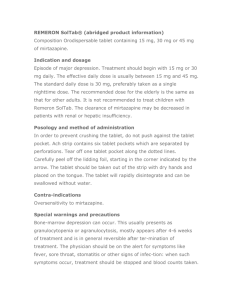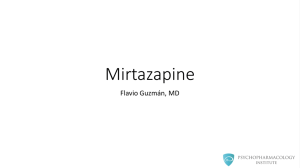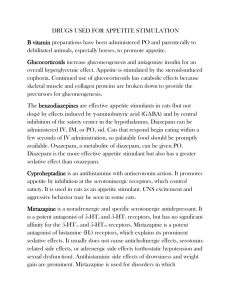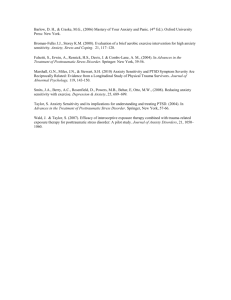Off-label use of mirtazapine for anxiety OFF-LABEL MEDICATIONS: EVIDENCE-BASED USE
advertisement
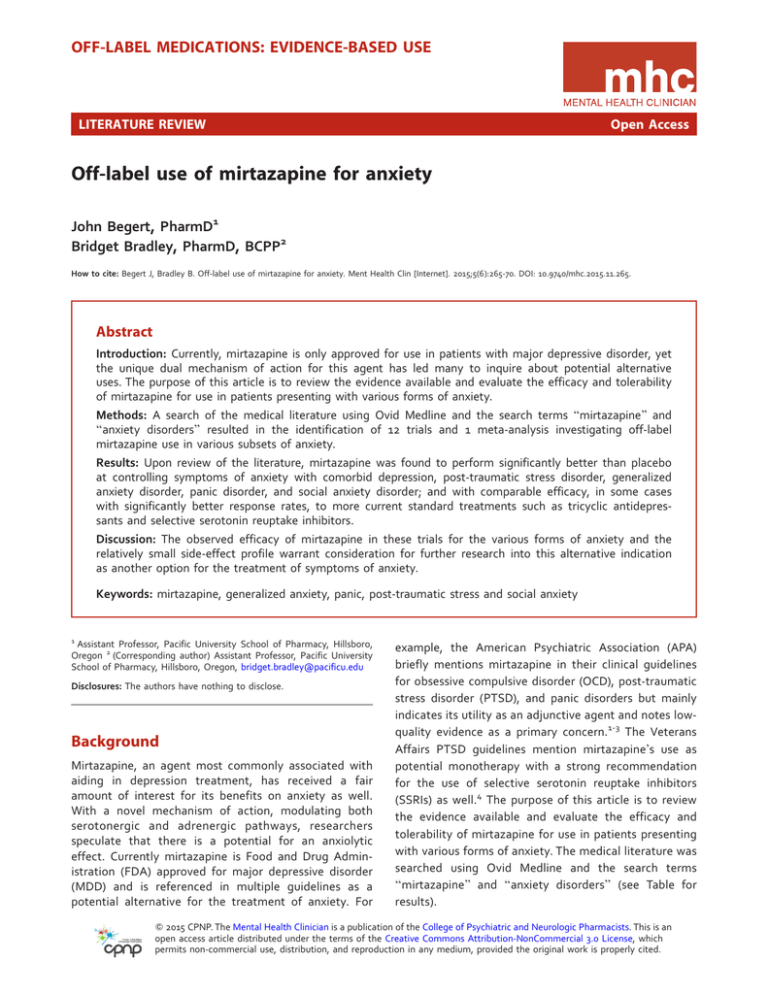
OFF-LABEL MEDICATIONS: EVIDENCE-BASED USE LITERATURE REVIEW Open Access Off-label use of mirtazapine for anxiety John Begert, PharmD1 Bridget Bradley, PharmD, BCPP2 How to cite: Begert J, Bradley B. Off-label use of mirtazapine for anxiety. Ment Health Clin [Internet]. 2015;5(6):265-70. DOI: 10.9740/mhc.2015.11.265. Abstract Introduction: Currently, mirtazapine is only approved for use in patients with major depressive disorder, yet the unique dual mechanism of action for this agent has led many to inquire about potential alternative uses. The purpose of this article is to review the evidence available and evaluate the efficacy and tolerability of mirtazapine for use in patients presenting with various forms of anxiety. Methods: A search of the medical literature using Ovid Medline and the search terms ‘‘mirtazapine’’ and ‘‘anxiety disorders’’ resulted in the identification of 12 trials and 1 meta-analysis investigating off-label mirtazapine use in various subsets of anxiety. Results: Upon review of the literature, mirtazapine was found to perform significantly better than placebo at controlling symptoms of anxiety with comorbid depression, post-traumatic stress disorder, generalized anxiety disorder, panic disorder, and social anxiety disorder; and with comparable efficacy, in some cases with significantly better response rates, to more current standard treatments such as tricyclic antidepressants and selective serotonin reuptake inhibitors. Discussion: The observed efficacy of mirtazapine in these trials for the various forms of anxiety and the relatively small side-effect profile warrant consideration for further research into this alternative indication as another option for the treatment of symptoms of anxiety. Keywords: mirtazapine, generalized anxiety, panic, post-traumatic stress and social anxiety 1 Assistant Professor, Pacific University School of Pharmacy, Hillsboro, Oregon 2 (Corresponding author) Assistant Professor, Pacific University School of Pharmacy, Hillsboro, Oregon, bridget.bradley@pacificu.edu Disclosures: The authors have nothing to disclose. Background Mirtazapine, an agent most commonly associated with aiding in depression treatment, has received a fair amount of interest for its benefits on anxiety as well. With a novel mechanism of action, modulating both serotonergic and adrenergic pathways, researchers speculate that there is a potential for an anxiolytic effect. Currently mirtazapine is Food and Drug Administration (FDA) approved for major depressive disorder (MDD) and is referenced in multiple guidelines as a potential alternative for the treatment of anxiety. For example, the American Psychiatric Association (APA) briefly mentions mirtazapine in their clinical guidelines for obsessive compulsive disorder (OCD), post-traumatic stress disorder (PTSD), and panic disorders but mainly indicates its utility as an adjunctive agent and notes lowquality evidence as a primary concern.1-3 The Veterans Affairs PTSD guidelines mention mirtazapine’s use as potential monotherapy with a strong recommendation for the use of selective serotonin reuptake inhibitors (SSRIs) as well.4 The purpose of this article is to review the evidence available and evaluate the efficacy and tolerability of mirtazapine for use in patients presenting with various forms of anxiety. The medical literature was searched using Ovid Medline and the search terms ‘‘mirtazapine’’ and ‘‘anxiety disorders’’ (see Table for results). Q 2015 CPNP. The Mental Health Clinician is a publication of the College of Psychiatric and Neurologic Pharmacists. This is an open access article distributed under the terms of the Creative Commons Attribution-NonCommercial 3.0 License, which permits non-commercial use, distribution, and reproduction in any medium, provided the original work is properly cited. TABLE: Study results Study Design; Treatments Duration Primary Anxiety Outcome Results Fawcett and Barkin, 19985 Meta-analysis Variable HAM-D items 9-15 and 17 Kim et al, 20116 N ¼ 60 Open-label; mirtazapine vs paroxetine N ¼ 137 Randomized double-blind; mirtazapine vs citalopram N ¼ 15 Open-label; mirtazapine only, alprazolam or triazolam if needed N ¼ 14 Open-label; mirtazapine only, alprazolam or triazolam if needed N ¼ 29 Randomized placebo controlled; mirtazapine only 8 weeks HAM-D HARS 8 weeks HAM-A Statistically significant difference favoring mirtazapine at week 2 8 weeks SIP SPRINT IES-R Significant improvement over baseline for all end points 24 weeks SIP SPRINT IES-R Significant improvement over baseline in SPRINT scores No statistically significant reduction in SIP or IES-R scores 8 weeks SIP SPRINT HADS-A 6 weeks SPRINT IES-R Significant improvement over baseline for SIP and IES-R scores No statistically significant reduction in SPRINT scores No statistically significant difference in end points between treatment groups 12 weeks HAM-A Significant improvement over baseline for end point 8 weeks HAM-A CGI-I No statistically significant difference in end points between treatment groups 12 weeks LSAS Significant improvement over baseline for end point 12 weeks LSAS FNES No statistically significant difference in end points between treatment groups 10 weeks SPIN LSAS Significant improvement over baseline for all end points Leinonen et al, 19997 Bahk et al, 20028 Kim et al, 20059 (continuation of Bahk) Davidson et al, 200311 Chung et al, 200412 Gambi, 200513 Ribeiro et al, 200114 Van Veen et al, 200215 Schutters et al, 201016 Muehlbacher et al, 200517 N ¼ 113 Open-label; mirtazapine vs sertraline N ¼ 44 Open-label; mirtazapine only N ¼ 27 Double-blind randomized; mirtazapine vs fluoxetine N ¼ 14 Open-label; mirtazapine only N ¼ 60 Randomized, double-blind; mirtazapine ODT vs placebo N ¼ 66 Randomized, double-blind; mirtazapine vs placebo No statistically significant difference between mirtazapine and amitriptyline groups No significant difference in end points CGI-I ¼ Clinical Global Impression; FNES ¼ Fear of Negative Evaluation Scale; HAM-A ¼ Hamilton Anxiety Rating Scale; HAM-D ¼ Hamilton Depression Rating Scale; HARS ¼ Hospital Anxiety Depression Scale anxiety subscale; IES-R ¼ Impact of Event Scale-Revised; LSAS ¼ Liebowitz Social Anxiety Scale; SIP ¼ Structured Interview for PTSD; SPRINT ¼ Short PTSD Rating Interview. Major Depressive Disorder With Comorbid Anxiety Major depressive disorder is commonly associated with a comorbid presentation of anxiety, which has been estimated to be present in 50% to 70% of patients diagnosed with MDD.5 This high level of correlation has led many to investigate whether or not correlations in efficacy exist between treatment modalities as well. One meta-analysis that included eight, 6-week, randomized, double-blind, placebo- and active-controlled trials looked to investigate this correlation and determine the efficacy for the use of mirtazapine in patients with anxiety and comorbid MDD. All studies were performed in the United States and assessed mirtazapine’s efficacy of controlling symptoms of anxiety/agitation and anxiety/somatization using the Hamilton Depression Rating (HAM-D) scale. Anxiety/agitation were assessed using items 9, 10, and 11 on the HAM-D scale, while anxiety/somatization took into Ment Health Clin [Internet]. 2015;5(6):265-70. DOI: 10.9740/mhc.2015.11.265 266 account items 10, 11, 12, 13, 15, and 17. Of the studies that were included, 4 investigated amitriptyline as an active control, while the other 4 compared mirtazapine against placebo. In the placebo-controlled studies, patients in the mirtazapine group demonstrated a significant reduction in symptoms of anxiety/agitation by study endpoint, with a mean reduction in HAM-D scores of 3.2 6 0.02 points for mirtazapine and 1.9 6 0.02 points for placebo (P , .05). This significant reduction was also observed in the mirtazapine groups as early as the first week of treatment. Similar results were also seen in the reduction of anxiety/ somatization symptoms as early as week 1 and remained significant until the endpoint. However, a significant difference in the reduction of symptoms was not observed between mirtazapine and amitriptyline. While HAM-D scores for both anxiety/agitation and anxiety/somatization decreased throughout the 6-week time frame, mean reductions in the scores were not shown to be significantly different. Mean reductions from baseline for anxiety/ agitation scores were 3.5 points for mirtazapine and 3.2 for amitriptyline (not significant), while mean reductions in anxiety/somatization scores were 0.53 for mirtazapine and 0.52 for amitriptyline (not significant).5 Despite the lack of significant differences between the 2 agents, the meta-analysis does present meaningful evidence for the use of mirtazapine for the treatment of anxiety with comorbid depression. Although improvement was comparable, amitriptyline, along with the entire class of tricyclic antidepressants (TCAs), is also not currently FDA approved for use in patients with anxiety and thus does not present the best comparison. However, in 2 trials that compared mirtazapine to SSRIs, the current standard of care for treatment of both MDD and anxiety, mirtazapine worked as well as both paroxetine and citalopram.6,7 The paroxetine study, which administered mirtazapine at 15 to 30 mg/d in 60 patients for 8 weeks, found that mirtazapine performed as well as paroxetine (10-20 mg/d) at improving symptoms of both depression and anxiety. Those in the mirtazapine group experienced significant reductions in symptoms as early as week 1; however, this difference was not present by week 4. There was also no significant difference in the number of responders between the 2 groups (determined by more than a 50% reduction in Hamilton Depression Rating scale [HAM-D] and Hamilton Anxiety Rating Scale [HAM-A] scores by endpoint), with 19 of 29 responding (based on HAM-D scores) and 14 of 29 responding (based on HAM-A scores) for mirtazapine compared with 20 of 29 responding (based on HAM-D scores) and 8 of 29 responding (based on HAM-A scores) for the paroxetine group. While these differences in values are not significant, there is a trend toward favoring mirtazapine, particularly regarding a reduction in anxiety symptoms.6 In the study that compared mirtazapine against citalopram, another currently FDA-approved first-line agent for depression (used off-label for the treatment of anxiety) similar results were achieved. This study of 137 patients found that mirtazapine (mean dose, 35.9 mg/d) was as effective as citalopram (mean dose, 36.6 mg/d) at reducing symptoms of depression and anxiety. Symptoms continued to trend downward during the 8-week trial for both groups, as measured by the Hamilton Anxiety Rating Scale (HAM-A) scale, with one statistically significant difference being observed at week 2 in favor of mirtazapine (P ¼.033).7 A total of 85.3% of patients treated with mirtazapine were deemed to have been responders to treatment, according to the Clinical Global Impression (CGI), Severity of Illness and Quality of Life scores, compared with 88.7% who responded in the citalopram group (P ¼.538).7 Post-Traumatic Stress Disorder Numerous studies have been performed internationally to investigate mirtazapine and determine if indeed there is a link between mirtazapine and its unique mechanism of action in improving/reducing symptoms of PTSD and anxiety. In one of those studies, conducted in Korea, Bahk et al8 enrolled 15 patients (10 male, 5 female) with a confirmed diagnosis of PTSD. Severity of PTSD symptoms was evaluated throughout the 8-week period using the Structured Interview for PTSD (SIP), the Short PTSD Rating Interview (SPRINT), the Impact of Event ScaleRevised (IES-R), and the Montgomery Asberg Depression Rating Scale (MADRS). Protocol allowed for a 3- to 7-day washout period for those patients previously on alternative antidepressant medications (3 on paroxetine, 2 on imipramine, and 1 on fluoxetine). Upon completion of the study, investigators observed that while receiving an average daily dose of 29 mg mirtazapine per day, a statistically significant reduction in all PTSD instrumentmeasured scores from baseline to study endpoint was observed. In addition to average score reductions, a greater than 50% reduction in scores by week 8 was observed in 63% (9 of 15) of patients on the IES-R, 53.3% (8 patients) on the SPRINT, and 53.3% (8 patients) on the SIP, with no subjects dropping from the study because of adverse events.8 With this promising information and upon finalization of the study, investigators Kim et al9 decided to continue the initial study and extend the treatment period by another 16 weeks to assess for any additional benefit. Previous studies investigating the use of mirtazapine for anxiety have mostly been small, 6- to 8-week studies, with minimal evidence for long-term benefits of the intervention. Fourteen of the original 15 patients agreed to continue with the study and were assessed at weeks 12 and 24 using the same instruments as in the previous 8-week trial. Patients were allowed to continue with their mirtazapine regimen (average daily dose of 27 Ment Health Clin [Internet]. 2015;5(6):265-70. DOI: 10.9740/mhc.2015.11.265 267 mg/d with average maximum dose of 35 mg/d), as well as alprazolam if needed (average dose at the end of 8-week time period 1.21 6 0.32 mg/d, which reduced to 0.63 6 0.52 mg/d by week 24). When taking into account the entire 24-week duration from the 2 studies combined, mean PTSD scores in patients decreased significantly from baseline across the evaluation instruments. However, when mean scores were analyzed for significance in reduction from the end of the 8-week trial onward, only the SPRINT scale revealed a significant reduction (P ¼.015), with 10 patients (83.2%) being classified as responders according to their SPRINT scores by week 24, compared with only 5 patients (41.6%) responding to treatment by the end of the previous 8week trial. No statistical significance in mean score reduction or number of responders beyond week 8 was noted for the SIP or IES-R instruments, but a downward trend in PTSD severity was observed.9 While statistically significant results beyond week 8 were not as robust as in the previous trial by Bahk et al,8 the reduction in the SPRINT scores, a vetted and useful tool for evaluating PTSD symptom severity and global improvement, is an interesting finding in the evaluation of the efficacy for the use of mirtazapine in PTSD.10 In one of the few placebo-controlled trials investigating mirtazapine for PTSD use, Davidson et al11 randomized 29 subjects to receive either mirtazapine or placebo. Following the 8-week trial, the response rates of the 20 patients who completed the trial were significantly greater among the mirtazapine group compared with the placebo group (78.6% versus 16.7%; P ¼.01, based on improvement of global improvement item of SPRINT), as well as in the intention to treat analysis (64.7% versus 22.2%; P ¼.04). However, no difference was found on the total SPRINT score. Secondary analyses of the SIP and Hospital Anxiety Depression Scale anxiety subscale scores also showed a significant benefit with mirtazapine.11 While the previously presented studies focused on the efficacy of mirtazapine by itself or against placebo, few studies have been performed comparing mirtazapine to currently recommended standards of care for PTSD. One Korean study compared the efficacy of mirtazapine against sertraline for patients diagnosed with PTSD following the Korean or Vietnam wars. In the 6-week study, 113 veterans were randomized to receive either mirtazapine or sertraline following a 7-day washout period. Upon completion of the study, improvements were noted for the mirtazapine group compared with the sertraline group for reduction in Clinician-Administered PTSD Scale-2 (CAPS-2) scores from baseline to week 6 (43.4% versus 37.4%; P ¼.47), but not in the Hamilton Depression Rating Scale-17 (HAMD-17) scores from baseline to week 6 (58.5% versus 59.1%). Even though the head-to-head comparison did not yield significant differences in terms of improvement of symptoms, they were comparable, and both agents did demonstrate statistically significant reductions in CAPS-2 and HAMD17 scores overall by the week-6 endpoint. It was also observed that the number of responders (CAPS-2 scores, "30% decrease from baseline) was higher in the mirtazapine group, with a nonsignificant difference seen as early as weeks 1 and 2.12 This rapid onset is a characteristic that has been noted in previous trials discussed in this article for patients with anxiety and MDD but has not been observed in the other PTSD trials thus far. However, this observation could be skewed, as the mirtazapine group had a higher baseline CAPS-2 score, which could result in greater reductions following treatment. Generalized Anxiety Disorder In a 12-week, open-label, fixed-dose (30 mg/d) study, mirtazapine was given to 44 adult patients with a diagnosis of generalized anxiety disorder (GAD) (average duration of illness, 12.3 years) and evaluated based on the primary outcome of improvement in HAM-A total scores. Of the 39 patients who completed the study in its entirety, HAM-A scores were observed to have a mean reduction of 63.3% from baseline. Changes from baseline were noted to be statistically significant as early as week 1 (Bonferroni t ¼ 4.8, P , .001). Thirty-five patients had a "50% reduction in HAM-A scores, and of those 35 patients, 16 reached remission with HAM-A scores #7. Nine patients, which includes dropouts using the last observation carried forward, were identified as nonresponders with a HAM-A reduction ,50% from baseline. Significant reductions from baseline were also observed in the secondary outcomes for Clinical Anxiety Scale (CAS), Irritability Depression and Anxiety Scale (IDAS-A), MADRS, and Sheehan Disability Scale (SDS) scores.13 Side effects were minimal and mild for the mirtazapine group, which resulted in few dropouts (n ¼ 5), and were primarily due to sedation and weight gain. Patients with comorbid illnesses, including depression, were included in the study, allowing for greater external validity. However, as the study did not purposefully intend to look at the effects for mirtazapine in patients with both GAD and MDD, it was viewed under its own separate subheading. Panic Disorder In the randomized controlled trial, mirtazapine was compared with fluoxetine, an agent FDA approved for the treatment of panic disorder (PD). The 8-week, doubleblind, randomized controlled trial, with a 1-week run-in period, studied 27 patients (mean duration of illness, 36 months) after taking either mirtazapine (n ¼ 14; average Ment Health Clin [Internet]. 2015;5(6):265-70. DOI: 10.9740/mhc.2015.11.265 268 dose, 17.9 mg/d) or fluoxetine (n ¼ 13; average dose, 13.1 mg/d). The primary focus of the study was to examine the number of panic attacks per week as compared with baseline and improvement in symptoms as measured by the HAM-A and the Clinical Global Impression-Improvement scale (CGI-I). No difference was seen between the 2 treatment groups regarding panic attacks per week. Both groups experienced a median of zero panic attacks per week by the end of the study and saw a reduction in HAM-A scores for mirtazapine and fluoxetine of 15 and 17 points, respectively. The only significant difference between the 2 groups was seen in the patient global evaluation of phobic anxiety (P ¼.016), which favored the use of mirtazapine. Adverse events were similar between the 2 groups, with 3 patients dropping out in the fluoxetine group (nausea and vomiting, epigastric pain, headache, and tremor) and 2 in the mirtazapine group (drowsiness, dyslalia, increased anxiety, and tremor).14 This trial is one of the few to actively compare mirtazapine to current standards of care. Social Anxiety Disorder One small pilot study conducted in 2002 investigated the efficacy of mirtazapine at controlling SAD symptoms in 14 patients with SAD. Patients were given 30 mg mirtazapine for 12 weeks and were primarily evaluated using the Liebowitz Social Anxiety Scale (LSAS). Upon completion of the study, mean LSAS total scores of 12 study finishers decreased from 72.6 6 5.11 to 48 6 8.18, with 5 of those patients being deemed responders to treatment. The patients who were classified as responding to treatment were followed for an additional 12 weeks to assess for any long-term benefits, yet no significant changes or improvements in symptoms were observed after 24 weeks.15 In contrast to this study, however, Schutters et al found different results when investigating the efficacy of mirtazapine for controlling SAD.16 In the 12-week, double-blind, randomized controlled trial, 60 patients received mirtazapine orally disintegrating tablet (ODT) formulation (dosed between 30 and 45 mg/d) or placebo. Patients were evaluated using the LSAS, the Fear of Negative Evaluation Scale (FNES), and the SDS. Patients were deemed to have responded to treatment if there was at least a 40% reduction in LSAS scores. While scores were observed to have improved from baseline with both mirtazapine and placebo, no significant differences were seen between the 2 groups. Various differences in comparison with other studies may be partly to blame for the negative findings, such as different mirtazapine formulations, lack of comorbid diagnoses such as depression, and more patients with less severe forms of SAD in the mirtazapine group (baseline LSAS scores: 68.3 for mirtazapine, 73.8 for placebo).16 Subgroup analyses of the men and women in the study also failed to find any significant differences as it relates to sex. The investigation between differences in treatment effect based on sex came as a result of a previous study by Muehlbacher et al, 17 which observed a significant response in women with SAD taking mirtazapine during their randomized, double-blind, placebocontrolled trial. This study, which included 66 women, evaluated them according to change in the Social Phobia Inventory (SPIN) and the LSAS tools. At study completion, it was noted that significant improvement was seen in both the SPIN and the LSAS scores. Unlike the previous study, in which all participants were considered to have ‘‘pure SAD,’’ the majority of the women in this study had concurrent diagnoses of personality disorders (mirtazapine, 27.3%; placebo, 24.2%), GAD (mirtazapine, 45.4%; placebo, 45.4%), PD (mirtazapine, 18.2%; placebo, 24.2%), and OCD (mirtazapine, 6.1%; placebo, 9.1%) and may have seen an improvement in their SAD owing to improvements in their other comorbid illnesses as well.17 Conclusion The trials reviewed in this article demonstrate that in comparison with placebo, mirtazapine performed significantly better at controlling symptoms of anxiety with comorbid depression, post-traumatic stress disorder, generalized anxiety disorder, panic disorder, and social anxiety disorder, and when compared with current standards of care for anxiety (particularly SSRIs) performed equally if not better than the other agents. It is important to point out that many of the trials noted a response to mirtazapine as compared with other current standard treatments in as little as 1 to 2 weeks, with a minimal and often mild side-effect profile. Most commonly reported adverse effects experienced by those taking mirtazapine were sedation, fatigue, weight gain, dry mouth, constipation, and headache. Unfortunately, upon review of the literature, it cannot be determined with certainty that the improvement seen in these patients was not due, in part, to the improvement in their other comorbid mental illnesses, such as depression, as was demonstrated in the studies by Chung et al and Gambi et al12,13 which observed no improvement in symptoms compared with placebo in patients with ‘‘pure social anxiety disorder.’’ However, mental illness is not all exclusive as was presented previously, with up to 50% to 70% of patients with anxiety concurrently having a diagnosis of MDD, and should not discount the observed benefit that mirtazapine presented in these trials. It has also been noted by various guidelines that the level and quality of the evidence currently available on this topic is relatively weak. Small sample sizes, short durations, and open-label designs lead to concerns of bias and issues Ment Health Clin [Internet]. 2015;5(6):265-70. DOI: 10.9740/mhc.2015.11.265 269 with extrapolation to a larger population. While some articles in the review were randomized with active controls, their sample sizes were limited, previous use of anxiolytic agents was not always evident, and therapy protocols fluctuated. While these limitations lead to difficulty in making a strong recommendation for or against the use of mirtazapine in anxiety, it should not overshadow the evidence that is currently available and the results that have been shown thus far. References 1. American Psychiatric Association. Practice guideline for the treatment of patients with obsessive-compulsive disorder. Arlington (VA): American Psychiatric Association; 2007. 2. American Psychiatric Association. Practice guideline for the treatment of patients with acute stress disorder and posttraumatic stress disorder. Arlington (VA): American Psychiatric Association; 2009. 3. American Psychiatric Association. Practice guideline for the treatment of patients with panic disorder. Arlington (VA): American Psychiatric Association; 2009. 4. Management of Post-Traumatic Stress Working Group. VA/DoD clinical practice guideline for management of post-traumatic stress. Washington (DC): Department of Veterans Affairs, Department of Defense; 2010. 5. Fawcett J, Barkin RL. A meta-analysis of eight randomized, double-blind, controlled clinical trials of mirtazapine for the treatment of patients with major depression and symptoms of anxiety. J Clin Psychiatry. 1998;59(3):123-7. PubMed PMID: 9541155. 6. Kim JE, Yoon SJ, Kim J, Jung JY, Jeong HS, Cho HB, et al. Efficacy and tolerability of mirtazapine in treating major depressive disorder with anxiety symptoms: an 8-week openlabel randomised paroxetine-controlled trial. Int J Clin Pract. 2011;65(3):323-9. DOI: 10.1111/j.1742-1241.2010.02624.x. PubMed PMID: 21314870. 7. Leinonen E, Skarstein J, Behnke K, Agren H, Helsdingen JT. Efficacy and tolerability of mirtazapine versus citalopram: a double-blind, randomized study in patients with major depressive disorder. Nordic Antidepressant Study Group. Int Clin Psychopharmacol. 1999;14(6):329-37. PubMed PMID: 10565799. 8. Bahk W-M, Pae C-U, Tsoh J, Chae J-H, Jun T-Y, Chul-Lee, et al. Effects of mirtazapine in patients with post-traumatic stress disorder in Korea: a pilot study. Hum Psychopharmacol. 2002; 17(7):341-4. DOI: 10.1002/hup.426. 9. Kim Won, Pae Chi-Un, Chae Jeong-Ho, Jun Tae-Youn, Bahk Won-Myong. The effectiveness of mirtazapine in the treatment of post-traumatic stress disorder: a 24-week continuation therapy. Psychiatry Clin Neurosci. 2005;59(6):743-7. DOI: 10. 1111/j.1440-1819.2005.01447.x. 10. Connor KM, Davidson JRT. SPRINT: a brief global assessment of post-traumatic stress disorder. Int Clin Psychopharmacol. 2001; 16(5):279-84. DOI: 10.1097/00004850-200109000-00005. 11. Davidson JRT, Weisler RH, Butterfield MI, Casat CD, Connor KM, Barnett S, et al. Mirtazapine vs. placebo in posttraumatic stress disorder: a pilot trial. Biol Psychiatry. 2003;53(2):188-91. PubMed PMID: 12547477. 12. Chung MY, Min KH, Jun YJ, Kim SS, Kim WC, Jun EM. Efficacy and tolerability of mirtazapine and sertraline in Korean veterans with posttraumatic stress disorder: a randomized open label trial. Hum Psychopharmacol. 2004;19(7):489-94. DOI: 10.1002/ hup.615. 13. Gambi F, De Berardis D, Campanella D, Carano A, Sepede G, Salini G, et al. Mirtazapine treatment of generalized anxiety disorder: a fixed dose, open label study. J Psychopharmacol. 2005;19(5):483-7. DOI: 10.1177/0269881105056527. PubMed PMID: 16166185. 14. Ribeiro L, Busnello JV, Kauer-Sant’Anna M, Madruga M, Quevedo J, Busnello EAD, et al. Mirtazapine versus fluoxetine in the treatment of panic disorder. Braz J Med Biol Res. 2001; 34(10):1303-07. DOI: 10.1590/S0100-879X2001001000010. 15. Van Veen JF, Van Vliet IM, Westenberg HGM. Mirtazapine in social anxiety disorder: a pilot study. Int Clin Psychopharmacol. 2002;17(6):315-7. PubMed PMID: 12409686. 16. Schutters SIJ, van Megen HJGM, Van Veen JF, Denys DAJP, Westenberg HGM. Mirtazapine in generalized social anxiety disorder: a randomized, double-blind, placebo-controlled study. Int Clin Psychopharmacol. 2010;25(5):302-4. PubMed PMID: 20715300. 17. Muehlbacher M, Nickel MK, Nickel C, Kettler C, Lahmann C, Pedrosa Gil F, et al. Mirtazapine treatment of social phobia in women: a randomized, double-blind, placebo-controlled study. J Clin Psychopharmacol. 2005;25(6 ):580-3. PubMed PMID: 16282842. Ment Health Clin [Internet]. 2015;5(6):265-70. DOI: 10.9740/mhc.2015.11.265 270
